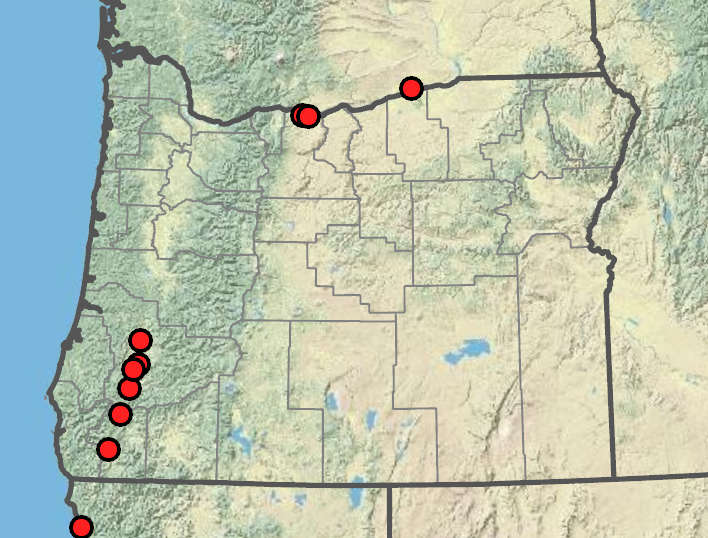Polypogon maritimus
Polypogon interruptus
Mediterranean beardgrass
ditch beardgrass
sheaths glabrous; the uppermost sheaths sometimes inflated;
ligules to 7 mm;
blades (1)3–9(14)cm × 0.5–5 mm.
sheaths smooth;
ligules 2–6 mm;
blades 5–9 cm × 3–6 mm.
narrowly ellipsoid, sometimes lobed; (1)2– 8(15)cm;
pedicels to 0.5 mm;
stipes 0.1–1.2 mm.
usually interrupted or lobed, 3–15 × 0.5–3 cm;
pedicels not developed;
stipes 0.2–0.7 mm.
1.8– 8.2 mm, ciliate, with large hairs or protrusions in the lower half;
tips lobed;
lobes 0.3–1.2 mm; about 17% as long as the glume body, awned;
glume awns 4–10 mm; yellowish.
2–3 mm, scabrous; larger prickles extending up the keel beyond mid-length;
glumes not tapering to the tips;
tips acute to truncate, unlobed or the lobes to 0.1 mm, awned;
glume awns 1.5–3.2 mm.
0.5– 1.5 mm, glabrous, awned or awnless;
lemma awns 0–1 mm.
0.8– 1.5 mm, glabrous; smooth;
tips obtuse, not emarginate, awned;
lemma awns 1–3.2 mm.
0.4–0.5 mm.
0.5–0.7 mm.
=14, 42.
=42.
Polypogon maritimus
Polypogon interruptus
Disturbed wet sites, streamsides. 100–300m. Sisk. CA, NV; FL, GA, SC; Eurasia. Exotic.
This rare or overlooked introduction has lobed, ciliate glumes that look almost spiny near the base.
Wet, often disturbed sites. 0–500m. Est, Sisk, WV. CA, ID, NV, WA; east to NE, southeast to LA, south to South America; NY, WI. Native.
Polypogon interruptus has a lobed inflorescence somewhat like a sparse P. monspeliensis but with shorter awns. A similar grass, P. fugax, was collected in Portland in 1902 and 1916. It is an annual with leaves 2–11 mm wide. Its glume tips are acute to rounded and have lobes 0.1–0.2 mm. Its lemma awns are up to 2 mm.
Barbara Wilson, Richard Brainerd, Nick Otting
Barbara Wilson, Richard Brainerd, Nick Otting
- Local floras:
CA,
OR,
WA
- Local Web sites:
CalFlora,
CalPhotos,
Flora NW,
PNW Herbaria
WildflowerSearch
iNaturalist (observations)
USDA Plants Database
- LBJ Wildflower Center
- SEINet
- Plants of the World Online
- Encyclopedia of Life
- Wikipedia
- Google Image Search
- Local floras:
BC,
CA,
OR,
WA
- Local Web sites:
CalFlora,
CalPhotos,
Flora NW,
PNW Herbaria
WildflowerSearch
iNaturalist (observations)
USDA Plants Database
- LBJ Wildflower Center
- SEINet
- Plants of the World Online
- Encyclopedia of Life
- Wikipedia
- Google Image Search



